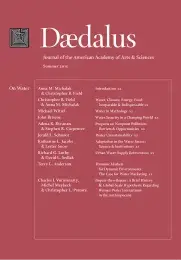Water Unsustainability
Water is a vital renewable resource that is increasingly stressed by multiple and competing demands from people, industry, and agriculture. When water becomes unavailable or unusable, life itself cannot be sustained. Changes in supply and demand for water are driven by population growth, climate change, and our energy and land use choices. Poverty frequently precludes the ability of many people to respond and adapt to water insecurity. In this essay, we discuss the effects of these drivers on the diminution of rivers, aquifers, glaciers, and the severe pollution that renders some water resources unusable. While technologies for water reuse, desalination, aquifer replenishment, and better water pricing are important solutions, the recognition of water as a profoundly threatened resource and as a basic human right is essential for providing sustainable water for future generations.
Water unsustainability is more easily understood than water sustainability: you know when you do not have it. When water is unavailable or when it is of unusably poor quality, life itself is unsustainable.
So how do we define water sustainability? Definitions usually involve the concept of long-term water availability for all uses. Supplying water to people for the duration of their lives is one definition, but is limited by a rather ethnocentric point of view. More broadly, we may define water sustainability as the continual supply of clean water for human uses and for the use of all other living organisms. This definition neither specifies exactly how much water is needed, nor does it require the unconstrained, infinite availability of water. Rather, it refers to a sufficient quantity of pure water for the foreseeable future for all biota, including humans.
Water is, after all, a renewable resource; sustaining its uses should be relatively easy. But in reality, we can have too much water or too little water at different times, and the water available may be of too poor quality. Water availability is often constrained by natural processes associated with the hydrologic cycle and geologic setting, or by jurisdictional boundaries of governmental authorities and water law. Water supply is also constrained by existing infrastructure to deliver available water. Our ability to ensure enough clean water for human uses is strongly influenced by the cost of water delivery and the price of and demand for water. Thus, many factors and trends affect the availability of water in space and time.
Because H2O does not cross the boundaries of our atmosphere, either to or from outer space, Earth has held the same quantity of water for eons. Earth’s hydrologic cycle is driven by the sun, which evaporates water from oceans, lakes, and streams, and causes vegetation to transpire water. Thus, water is in a continuous flux from evaporation to precipitation, resulting in the recycling, purification, and redistribution of it. However, the quality of water and the fraction of H2O in each water phase (gaseous, liquid, solid) at a given location are subject to change.
Currently, more than 99 percent of all water on Earth is unavailable for human use because it is too saline (in the form of seawater) or is frozen as glaciers, ice, or snow. With a stored volume of about two million cubic miles, groundwater remains the largest component of freshwater available for humans. Lakes and streams represent the next largest stores at approximately thirty thousand cubic miles.1 But the volume of freshwater stored in glaciers is diminishing as a warmer climate begins to melt continental glaciers and the Greenland and Antarctic ice sheets. Many changes in water quality and quantity are driven by human activities–not nature.
. . .
